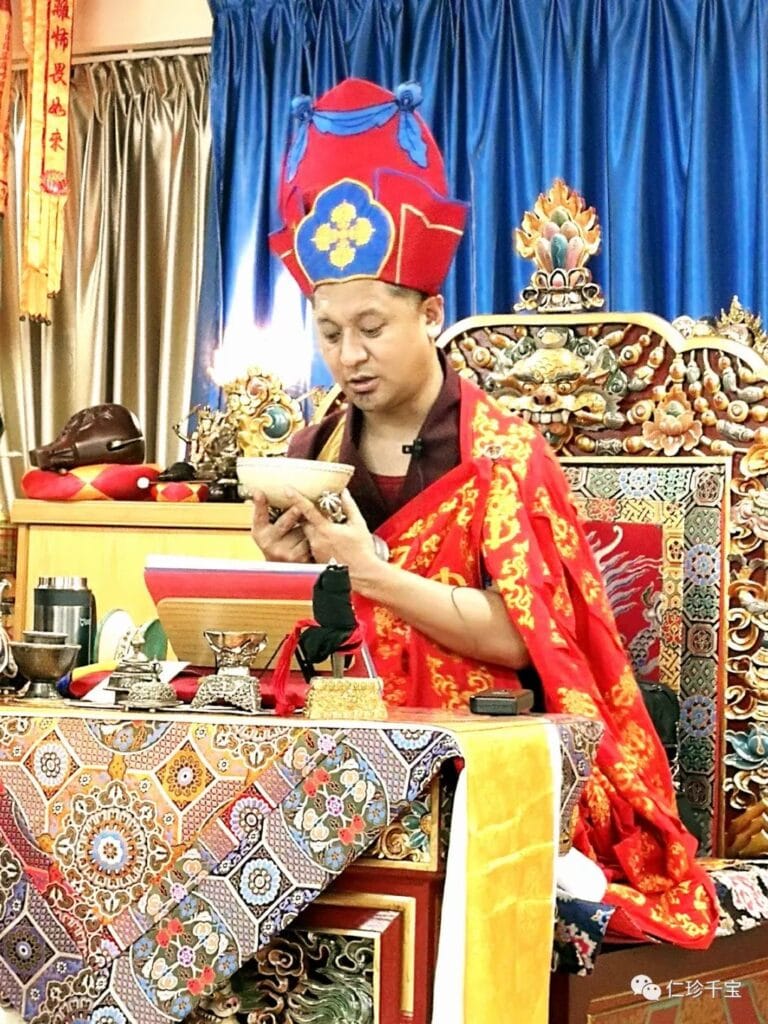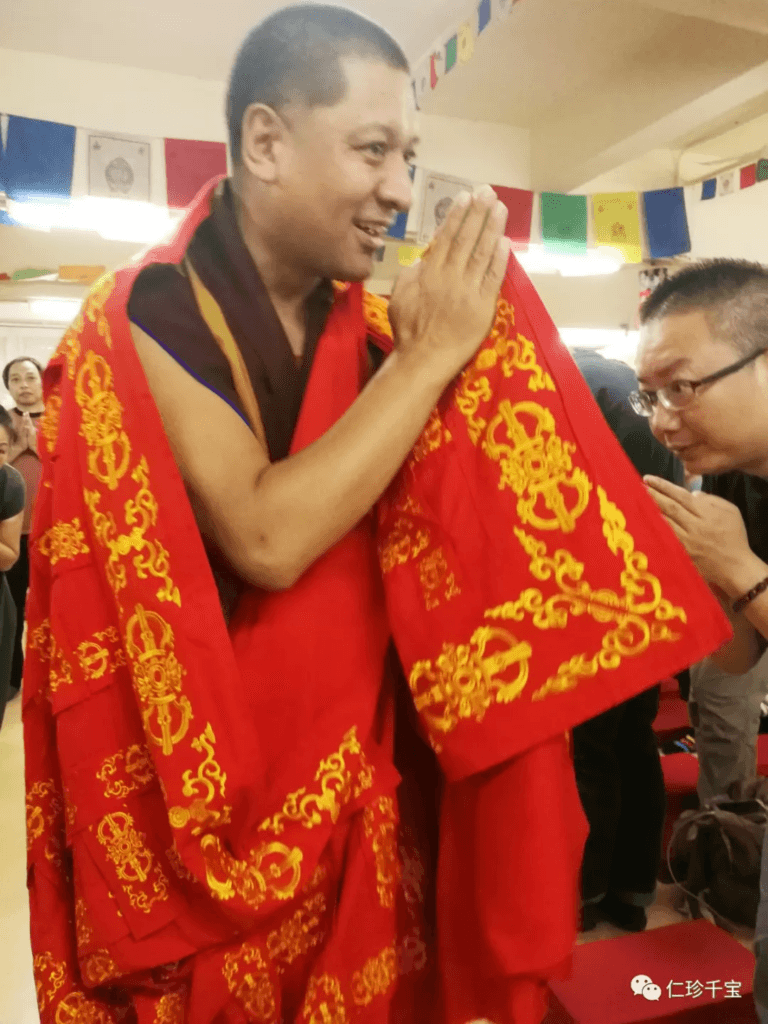
Master Rigzin Chenpo | Yutuo Transmission of Medicine Buddha
On May 29, 2019, the Medicine Buddha empowerment and teaching was given at the Hong Kong Life Center Yu Tuo Chuan Gui.
Medicine Buddha has reward body image and transformation body image, as well as the methods of the Action Tantra and the methods of the Highest Tantra. Most of the initiations of Medicine Buddha belong to the Karma Dharani method, and one must be a vegetarian when practicing the Karma Dharani method. In addition, no matter where you live, the clothes you wear must be clean, and you must observe the eight precepts. The practice of Medicine Buddha’s Dharma in the Highest Tantra is not that strict. The strict parts mainly concern the precepts of meditation and mantras, but there is no need to observe the eight precepts.
In Tibetan Buddhism, the inheritance of Medicine Buddha is divided into three types: the Old Translation inheritance, the New Jersey inheritance, and the hidden treasure inheritance. The Old Translation School is a distant transmission from the 7th to 8th century AD, which was passed down from the time of Guru Padmasambhava. The New Translation School’s tradition is a modern tradition, passed down by Master Atisha.

Features of Dharma:
1: The Yutuo Medicine Buddha Dharma that is being taught today is a hidden treasure lineage that was separated from the distant transmission Dharma. It was taken out from hidden treasures at different time periods by hidden treasure masters, and it has been passed down continuously from the seventh century AD to the present.
Second: It is the Sambhogakaya of Medicine Buddha, surrounded by four Gandhara goddesses. It is an empowerment of the supreme tantra and is the highest and most superior empowerment of Medicine Buddha.
- It is a method that all doctors in Tibetan Buddhism must practice. All pills must also be blessed through the rituals of this method.
Four: It is a method that combines Master Yutuo’s guru yoga method and the practice of Medicine Buddha.
The fundamental method of Yutuo Medicine Buddha is divided into the part of initiation, the part of ritual and the part of explanation. Initiations are divided into four categories: guru, deity, dakini and protector. Among them, guru is divided into outer, inner and secret; deity is divided into deity Medicine Buddha and deity Hayagriva; dakini is divided into Vajrayogini and Amrita (initiation of nectar); protectors are divided into empowerments of Medicine Fairy, Supernatural Boy, Immortal and Dragon Protector (outer, inner and initiation). The part explained is divided into the four preliminary practices, the generation stage, and the completion stage. The completion stage is further divided into the channels, drops, and energies of the completion stage with form, the completion stage without form, and the meditation without form. The ritual parts are divided into many types, such as long, medium, and short.
In the mid-to-late 19th century, when masters such as Jamyang Khyentse Wangpo and Jamgon Kongtrul Lodrö Taye were compiling the Great Treasure, they included Yuto Medicine Buddha in the 28th volume. It is a practice of entering into the brightness of the mind through the Great Perfection Anuyoga, and is an independent and complete system.
Dharma inheritance:
This lineage of Medicine Buddha has several names:
1: It is called the Far-Transmitted Medicine Buddha, also known as the Yutuo Chuangui (Yutuo Ningti, Yutuo Xinsui, Yutuo Xinyao) Medicine Buddha. Yutuo is the name of a Tibetan master. His medical skills are similar to those of Huatuo in China. He was the king of medicine in Tibet in the past.
2: The lineage called Sukalpa, Sukalpa is a famous Tibetan master;
3: It is called the Rigong Transmission Rules, which is the transmission of the Drikung Kagyu.
There was a very famous master in the Rigong Kagyu named Rinchen Chodragupta, who was the incarnation of Guru Padmasambhava and made great contributions to his lineage. He promoted the teachings of Guru Padmasambhava and the teachings of the Kagyu sect. He was a great accomplished master who practiced Manjushri Yamantriya. He highly respected the far-reaching Medicine Buddha, and so was also called the Rigong Buddha Master.
My Yutuo Medicine Buddha lineage was received from many masters:
Lineage 1: I received most of the oral transmission of Yuto Heart Sutra from my personal teacher Thubten Norbu, who was a doctor and had been chanting Medicine Buddha for a long time.
Lineage 2: Received empowerments and explanations of the Eight Buddhas of Medicine and the Heart of Yutuo from Guru Kangcang Terton.
Lineage 3: Received the empowerment of the Yuto Heart Sutra from His Holiness Penor Rinpoche.
Lineage 4: Received empowerment and oral transmission from the accomplished master Baiya Rinpoche.
Inheritance Five: Received oral transmission and explanation of the essentials of Yutuo from the imperial physician.
He has also received more than ten empowerments and oral transmissions, four lectures, and has gone through short-term retreats under many other masters.
In Vajrayana, inheritance is very important. It is like the river water, flowing continuously. To accept inheritance is to accept the blessings and blessings of all the ancestors of the inheritance. Today you have received my initiation and teachings, and I also extend my blessings to you all. We all develop a broad Bodhicitta, hoping that all sentient beings can escape from the sea of suffering and attain Nirvana; we develop a pure mind and visualize ourselves living in the Pure Land of Medicine Buddha, receiving empowerment under the seat of Medicine Buddha, and also visualizing the master as Medicine Buddha. With such faith and a pure mind, everyone can definitely receive the blessings of Medicine Buddha and all the ancestral masters of the lineage.

Appendix: Brief introduction of Yutuo Yundian Gongpo, the accomplished master of Medicine Buddha (organized according to online information)
Yutuo Yundian Gongbo is divided into the former Yutuo Yundian Gongbo and the latter Yutuo Yundian Gongbo. Qian Yutuo Yundian Gongbo was born in 729 AD in Doilung Jina, western Tibet. At the age of three, he learned to write and read with his father, listened to medical theories, and was quick-witted and able to cure diseases; at the age of five, he learned to write and read with his father, listened to medical theories, and was quick-witted and able to cure diseases; at the age of five, he received the permission rituals of Buddhist Tantric Buddhism such as “Sweet Mist Transforming Medicine” and “Medicine Buddha Practice Method” with his father; at the age of ten, the Tubo King Mei Acong summoned him to Samye to take the exam, and made him debate with Chandi Jenekap and other Tibetans, and all of them won full medical titles.
Based on the correct principles of logic and reasoning, he answered various questions posed by nine doctors from afar who were invited to Tibet, including the Indian doctor Xingdi Gaba, the Chinese doctor Dongsong Gangwa, etc. The wise men of Han and Tibetan unanimously praised him as the Medicine Buddha who came to the world. He first served as the imperial physician of the reigns of Me’achong and Trisong Detsen.
He took Chandarabi and the famous doctor Meiwang as his teachers, and listened to many medical theories such as “The Pearl Garland of the Four Continuations” and “The Key to the Knife and Needle”. Once he went to Mount Wutai in the Han area and asked the saint Manjushri for teachings such as “The Precious Garland of Formulas” and “The Meaning of Internal Medicine”.
His contributions include:
1: Based on Tibetan medicine, he drew on the essence of Chinese and Indian medicine and other medical books translated by Bai Ruozana to compile the famous work “Four Medical Classics” also known as “Four Sequels on Medicine”.
The Four Medical Classics consists of four volumes and 156 chapters. It is an authoritative reference book on Tibetan medicine that integrates the essence of Tibetan medicine practice and theory. It is known as the encyclopedia of Tibetan medicine and is the most systematic, complete and fundamental theoretical system in Tibetan medicine.
2: On the basis of inheriting traditional medicine, we have widely absorbed the excellent medical knowledge of other ethnic groups, established the theoretical system of Tibetan medicine, summarized the clinical practice experience and medical methods of Tibetan medicine, and strengthened the medical ethics and style training of Tibetan medical personnel.
- Created the first Tibetan institution to train medical talents, popularized medical knowledge, and promoted the development of Tibetan medicine.
- Establish a more reasonable medical system and degree system, and clarify training objectives.
He devoted his life to promoting medicine and died at the age of 125.
Hou Yutuo Yundian Gongbo is the 13th generation descendant of Qian Yutuo Yundian Gongbo. He was born in Nianduo Gexiretang, western Tibet in the 12th century. At the age of eight, he concentrated on learning medicine and became a good doctor. At the age of ten, he studied “The Four Continued Medical Studies” from Gunquejia. After he turned eighteen, he went to India six times to study medicine from the Vajrayogini goddess Palden Chengwa and the hermit Jaraka. He was well-versed in many theories and became famous in the five Indian countries. He became the teacher of thousands of learned people in Bodh Gaya.
After returning to Tibet, he practiced medicine and saved lives. He wrote many medical books, including “Essentials of the Eight Branches of Medicine” and “General Notes on the Essentials of Ma Ming’s Medical Science: Observation Treasure Mirror”, which benefited later generations. He also used the revised Tibetan version to revise the “Four Medical Continuations”, added marginal notes, supplemented the text as appropriate based on the differences in time and place, and enriched the annotations of the “Four Medical Continuations” with practical tips, compiled them into eighteen parts, and gave them to his disciple Yesong. He had many students, including nearly 300 famous doctors such as Songdun and Yeshesong. He died at the age of 77.
Both of them are great masters of Medicine Buddha who are now in Tibet. Their birthplace, parents, names, deeds and finally their rainbow body passing away are the same. They are great medical masters without any interruption in the order of their birth.
The faithful disciples only rely on their pure faith in the great master and their sincere respect for the Dharma, and organize the teachings according to the master’s teachings or recordings. I am a poor disciple who has deep karma and is suffering from the burning five poisons. I feel extremely guilty while editing this article. If I have misinterpreted the master’s intention or made any errors in the input, I bow down and repent to my master, the ancestor of the lineage, and fellow Taoists.
Om Benza Sattva Hum